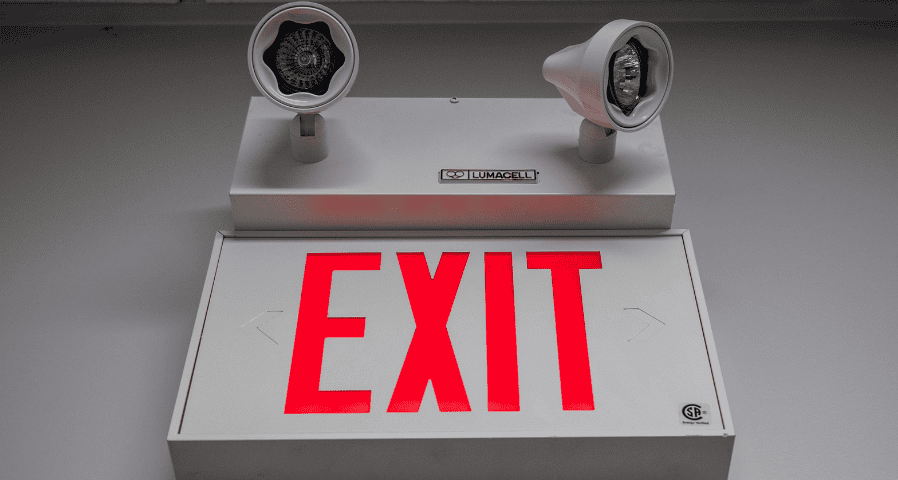In this blog post, we’ll explore the various types of emergency lighting, including maintained and non-maintained systems, as well as the latest advancements in LED technology, to help you understand their vital importance and how they can be implemented effectively in different settings.
What is Emergency Lighting Used For?
Emergency lighting is a critical safety feature designed to provide illumination when the primary power source fails, ensuring safe evacuation and emergency response. These lights activate automatically during power outages, fires, or other emergencies, reducing the risk of injury and panic by clearly marking escape routes and exits. They help to illuminate pathways, stairs, and doorways, guiding occupants to safety and aiding emergency personnel in their operations.
Additionally, emergency lighting supports essential activities in critical facilities like hospitals and fire stations, allowing them to continue functioning during a power disruption. By providing reliable illumination in times of crisis, emergency lighting systems play an indispensable role in maintaining safety and order.
Commercial facilities need to meet safety standards on local, state, and federal levels. Click here to read our latest blog, Commercial Building Emergency Lighting Requirements, to learn how to stay in compliance with safety requirements.
Types of Emergency Lighting
Emergency lighting comes in various forms, each designed to achieve the same goal of ensuring safety during an emergency. Let’s break down the different types:
Temporary or Standby Lighting
In some situations, activities must continue even during a power outage. Hospitals, prisons, and fire stations, for example, require temporary lighting to maintain operations. These lights vary in construction and size, suitable for both indoor and outdoor use.
Types of standby lighting include:
- Thermoplastic: Affordable and reliable, suitable for indoor use.
- Steel: Available in various voltages and wattages, ideal for warehouses and industrial applications.
- Wet Location: Waterproof and suitable for areas with moisture, featuring internal heaters for freezing temperatures.
- Architectural: Stylish designs that blend with upscale interiors, often with custom color options.
- Hazardous Location: Designed for environments with flammable gases or vapors, compliant with Class 1 Division 2 and Division 1 standards.
Exit Signs
Usually positioned above the nearest exits in a building. Recognizable by their red or green lettering spelling “EXIT” or illustrations pointing toward a safe escape, exit signs come in various types:
- Thermoplastic: Affordable and commonly used.
- Self-Luminous: Does not require an external power source.
- Photoluminescent: Absorbs light and glows in the dark.
- Edge-Lit: Offers a sleek, modern appearance.
Egress Pathways
Floor-mounted lights that glow in the dark, providing an escape route during a blackout. These pathways often consist of small LED bulbs, minimizing the chance of building occupants getting lost. They are commonly found in airplane aisles and theaters.
LED vs. Standard Bulkheads
Emergency lights can also differ in their operation. Traditional standard bulkheads operate like regular light bulbs, while LEDs use modern technology.
Standard Bulkheads are affordable and easy to maintain but are inefficient and can contain harmful chemicals. They require regular bulb replacements to avoid failure during an emergency.
LED Emergency Lights are more environmentally friendly, efficient, and have longer lifespans, lasting between 10,000 to 50,000 hours. They provide instantaneous light, crucial during emergencies, and help building managers save on electricity bills.
Maintained and Non-Maintained Emergency Lights
Emergency lighting can be categorized as maintained or non-maintained, determining when the lights activate.
Maintained Emergency Lights: flexible, remaining on before and during a power cut. These lights are often used in cinemas and theaters to avoid total darkness.
Non-Maintained Emergency Lights: only activate during a power cut, relying solely on their battery charged by the mains. These lights are more cost-effective and environmentally friendly but require a constant electricity flow for charging. They illuminate emergency exits only during an emergency, guiding occupants to safety.
Choosing the Right Emergency Lighting
Selecting the appropriate emergency lighting for a building involves considering safety, environmental impact, and cost. Maintained LED emergency lights are ideal for many buildings due to their efficiency and continuous operation. However, replacing standard bulkheads with LEDs may not be feasible for all buildings. The priority should always be the safety of the building’s occupants when deciding which emergency lighting to install.
Emergency lighting is a critical component of building safety, ensuring that people can evacuate safely during emergencies. Understanding the different types and their functions helps in making informed decisions about which lighting solutions to implement. Action Services Group provides national life safety lighting services and installations. To learn more, contact us at 610-558-9773, via email at [email protected] or schedule a call by clicking the button below.









































0 Comments
Trackbacks/Pingbacks